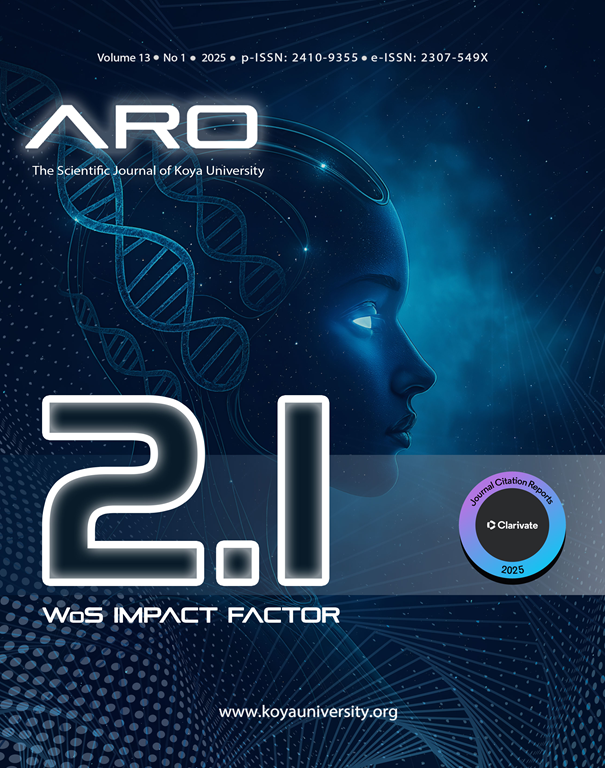Enhanced Pneumonia Detection from Chest X-rays Using Machine Learning and Deep Neural Architectures
DOI:
https://doi.org/10.14500/aro.12174Keywords:
Artificial Intelligence, Chest X-rays, Detection, Machine Learning, PneumoniaAbstract
Pneumonia is a major worldwide health concern, particularly for vulnerable groups such as babies and the elderly. Despite advances in medical imaging, diagnosing pneumonia using a chest X-ray remains difficult, due to the subtle presentation of symptoms and the variety in picture interpretation. This study utilizes modern machine learning can improve the accuracy and speed of diagnosing pneumonia using chest X-ray images. Utilizing a comprehensive dataset from the Kaggle online repository, consisting of over 5,000 annotated images, we evaluate the efficacy of various machine learning models including deep convolutional neural networks (CNN) and ensemble learning techniques. Our findings indicate that models like the Fuzzy opponent histogram filter combined with Logistic model trees (LMT) achieved the highest accuracy at 96.97%, while the deep learning-based Lenet (CNN) with LMT closely followed at 95.85%. The study aims to improve diagnostic precision, reduce interpretation discrepancies, and facilitate faster clinical decision-making by identifying the most effective machine learning approaches for real-world applications in healthcare settings.
Downloads
References
Ahishakiye, E., Van Gijzen, M.B., Tumwiine, J., Wario, R., and Obungoloch,J., 2021. A survey on deep learning in medical image reconstruction. Intelligent Medicine, 1(3), pp.118-127. DOI: https://doi.org/10.1016/j.imed.2021.03.003
Dasgupta, D., and Sen, H., 2024. PneuCoNet: A deep learning model for early detection of pneumonia & amp; COVID-19. In: Interdisciplinary Research in Technology and Management. United States, CRC Press, pp.223-227. DOI: https://doi.org/10.1201/9781003430469-26
Deepak, G.D., 2024. Optimization of deep neural network for multiclassification of Pneumonia. Computer Methods in Biomechanics and Biomedical Engineering Imaging and Visualization, 12(1), p.2292072. DOI: https://doi.org/10.1080/21681163.2023.2292072
El-Ghandour, M., and Obayya, M.I., 2024. Pneumonia detection in chest x-ray images using an optimized ensemble with XGBoost classifier. Multimedia Tools and Applications, 84(9), pp.5491-5521. DOI: https://doi.org/10.1007/s11042-024-18975-6
Hasan, M.D.K., Ahmed, S., Abdullah, Z.M.E., Monirujjaman Khan, M., Anand, D., Singh, A., AlZain, M., and Masud, M., 2021. Deep learning approaches for detecting pneumonia in COVID-19 patients by analyzing chest X-ray images. Mathematical Problems in Engineering, 2021, pp.1-8. DOI: https://doi.org/10.1155/2021/9929274
Kaur, N., and Singh, A., 2024. VGG16-PCA-PB3C: A hybrid PB3C and deep neural network based approach for leukemia detection. International Journal of Information Technology, 16(6), pp.3605-3615. DOI: https://doi.org/10.1007/s41870-024-01990-z
Khan, R., Taj, S., Ma, X., Noor, A., Zhu, H., Khan, J., Khan, Z.U., and Khan, S.U., 2024. Advanced federated ensemble internet of learning approach for cloud based medical healthcare monitoring system. Scientific Reports, 14(1), p.26068. DOI: https://doi.org/10.1038/s41598-024-77196-x
Kumar, T., Brennan, R., Mileo, A., and Bendechache, M., 2024. Image data augmentation approaches: A comprehensive survey and future directions. IEEE Access, 12, pp.187536-187571. DOI: https://doi.org/10.1109/ACCESS.2024.3470122
Kundu, R., Das, R., Geem, Z.W., Han, G.T., and Sarkar, R., 2021. Pneumonia detection in chest X-ray images using an ensemble of deep learning models. PLOS ONE, 16(9), p.e0256630. DOI: https://doi.org/10.1371/journal.pone.0256630
Li, X., Zhao, L., Zhang, L., Wu, Z., Liu, Z., Jiang, H., Cao, C., Xu, S., Li, Y., Dai, H., Yuan, Y., Liu, J., Li, G., Zhu, D., and Shen, D., 2023. Artificial General Intelligence for Medical Imaging Analysis. Carolina Digital Repository (University of North Carolina at Chapel Hill, United States.
Mittal, V., and Kumar, A., 2023. COVINet: A hybrid model for classification of COVID and Non-COVID pneumonia in CT and X-Ray imagery. International Journal of Cognitive Computing in Engineering, 4, pp.149-159. DOI: https://doi.org/10.1016/j.ijcce.2023.03.005
Pacal, I., Karaboga, D., Basturk, A., Akay, B., and Nalbantoglu, U., 2020. Acomprehensive review of deep learning in colon cancer. Computers in Biology and Medicine, 126, p.104003. DOI: https://doi.org/10.1016/j.compbiomed.2020.104003
Pant, A., Jain, A., Nayak, K.C., Gandhi, D., and Prasad, B.G., 2020. Pneumonia detection: An efficient approach using deep learning. 2020 11th International Conference on Computing, Communication and Networking Technologies (ICCCNT), pp.1-6. DOI: https://doi.org/10.1109/ICCCNT49239.2020.9225543
Racic, L., Popovic, T., Cakic, S., and Sandi, S., 2021. Pneumonia detection using deep learning based on convolutional neural network. 2021 25th International Conference on Information Technology (IT), pp.1-4. DOI: https://doi.org/10.1109/IT51528.2021.9390137
Rahman, T., Chowdhury, M.E.H., Khandakar, A., Islam, K.R., Islam, K.F., Mahbub, Z.B., Kadir, M.A., and Kashem, S., 2020. Transfer learning with deep convolutional neural network (CNN) for pneumonia detection using chest x-ray. Applied Sciences, 10(9), p.3233. DOI: https://doi.org/10.3390/app10093233
Rajpurkar, P., Irvin, J., Zhu, K., Yang, B., Mehta, H., Duan, T., Ding, D.,
Bagul, A., Langlotz, C., Shpanskaya, K., Lungren, MP., and Ng, Ay., 2017. CheXNet: Radiologist-Level Pneumonia Detection on Chest X-Rays with Deep Learning. arXiv (Cornell University), United States.
Ravi, V., 2024. Deep fine-tuned efficientNetV2 ensemble deep learning approach for pediatric pneumonia detection using chest radiographs. Journal of Intelligent and Fuzzy Systems, pp.1-18. DOI: https://doi.org/10.3233/JIFS-219397
Sailunaz, K., Alhajj, S., Özyer, T., Rokne, J., and Alhajj, R., 2024. Asurvey on brain tumor image analysis. Medical and Biological Engineering and Computing, 62(1), pp.1-45. DOI: https://doi.org/10.1007/s11517-023-02873-4
Selvanandhini, B., and Karthikeyan, R., 2024. Ensemble heartguard: Integrating svm and random forest for robust heart disease prediction. Educational Administration Theory and Practices, 30, pp.13091-13099. DOI: https://doi.org/10.53555/kuey.v30i5.5662
Shamshad, N., Sarwr, D., Almogren, A., Saleem, K., Munawar, A., Rehman, A.U., and Bharany, S., 2024. Enhancing brain tumor classification by a comprehensive study on transfer learning techniques and model efficiency using MRI datasets. IEEE Access, 12, pp.100407-100418. DOI: https://doi.org/10.1109/ACCESS.2024.3430109
Shein, A.M.S., Hongsing, P., Smith, O.K., Phattharapornjaroen, P., Miyanaga, K., Cui, L., Ishikawa, H., Amarasiri, M., Monk, P.N., Kicic, A., Chatsuwan, T., Pletzer, D., Higgins, P.G., Abe, S., and Wannigama, D.L., 2024. Current and novel therapies for management of Acinetobacter baumannii-associated pneumonia. Critical Reviews in Microbiology, 51, pp.441-462. DOI: https://doi.org/10.1080/1040841X.2024.2369948
Singh, S., Kumar, M., Kumar, A., Verma, B.K., Abhishek, K., and Selvarajan, S., 2024. Efficient pneumonia detection using vision transformers on chest X-rays. Scientific Reports, 14(1), p.2487. DOI: https://doi.org/10.1038/s41598-024-52703-2
Szepesi, P., and Szilágyi, L., 2022. Detection of pneumonia using convolutional neural networks and deep learning. Biocybernetics and Biomedical Engineering, 42(3), pp.1012-1022. DOI: https://doi.org/10.1016/j.bbe.2022.08.001
Thibault, J., Sauer, K.D., Bouman, C.A., and Hsieh, J., 2007. Athree‐dimensional statistical approach to improved image quality for multislice helical CT. Medical Physics, 34(11), pp.4526-4544. DOI: https://doi.org/10.1118/1.2789499
Venkatraman, K., and Reddy, S.N.P.S., 2024. Augmenting clinical decisions with deep learning lung cancer image abnormality segmentation. 2024 14th International Conference on Cloud Computing, Data Science & Engineering (Confluence), pp.674-678. DOI: https://doi.org/10.1109/Confluence60223.2024.10463381
Yang, J., Zheng, Y., Gou, X., Pu, K., Chen, Z., Guo, Q., Ji, R., Wang, H., Wang, Y., and Zhou, Y., 2020. Prevalence of comorbidities and its effects in patients infected with SARS-CoV-2: A systematic review and meta-analysis. International Journal of Infectious Diseases, 94, pp.91-95. DOI: https://doi.org/10.1016/j.ijid.2020.03.017
Downloads
Published
How to Cite
Issue
Section
License
Copyright (c) 2025 Kamal Upreti, Anju Singh, Divakar Singh, Preety Shoran, Uma Shankar, Meenakshi Yadav, Rituraj Jain

This work is licensed under a Creative Commons Attribution-NonCommercial-ShareAlike 4.0 International License.
Authors who choose to publish their work with Aro agree to the following terms:
-
Authors retain the copyright to their work and grant the journal the right of first publication. The work is simultaneously licensed under a Creative Commons Attribution License [CC BY-NC-SA 4.0]. This license allows others to share the work with an acknowledgement of the work's authorship and initial publication in this journal.
-
Authors have the freedom to enter into separate agreements for the non-exclusive distribution of the journal's published version of the work. This includes options such as posting it to an institutional repository or publishing it in a book, as long as proper acknowledgement is given to its initial publication in this journal.
-
Authors are encouraged to share and post their work online, including in institutional repositories or on their personal websites, both prior to and during the submission process. This practice can lead to productive exchanges and increase the visibility and citation of the published work.
By agreeing to these terms, authors acknowledge the importance of open access and the benefits it brings to the scholarly community.
Accepted 2025-05-18
Published 2025-06-10
















 ARO Journal is a scientific, peer-reviewed, periodical, and diamond OAJ that has no APC or ASC.
ARO Journal is a scientific, peer-reviewed, periodical, and diamond OAJ that has no APC or ASC.